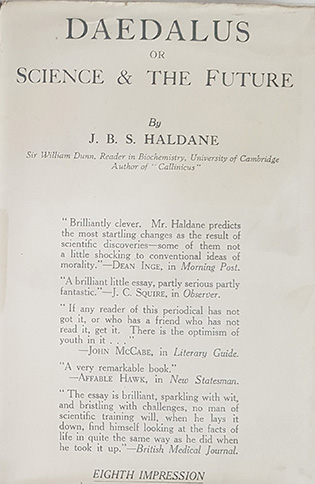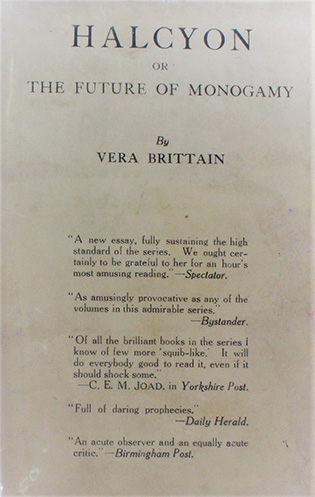Behind the FUTURES series…
In 1924, inspired by a sensational essay they had published the previous year, the publishers Kegan Paul launched a series of small, elegant books called To-Day and To-Morrow. The founding essay was Daedalus; or, Science and the Future, and its author, the biologist J. B. S. Haldane, made several striking predictions: genetic modification, wind power, artificial food.

But the idea that captured the imagination of his contemporaries was what he called ‘ectogenesis’ – the gestation of embryos in artificial wombs. Haldane’s friend Aldous Huxley included it in his novel Brave New World, in which humans are cloned and mass-produced in ‘Hatcheries’ (it was Haldane who later gave us the word ‘clone’). Fast- forward almost a century, and scientists have now trialled ectogenesis on sheep and are exploring its potential for saving dangerously premature babies.
Haldane took no prisoners as he hurtled through the ages and all the major sciences, weighing up what was still to be done. Perhaps because it was his discipline, he was convinced that the next exciting scientific discoveries would be made not in physics but in biology. So, his Daedalus is not the familiar pioneer of flight but the first genetic engineer – the designer of the contraption that enabled King Minos’s wife to mate with a bull and produce the Minotaur. Predictions have an unstable afterlife; their truth changes with the world, and while Haldane was brilliant on – and made a major contribution to – genetics, he was sceptical about the possibility of nuclear power. In the wake of the Second World War, and the realities of atom bombs, hydrogen bombs and nuclear power stations, his view of the sciences appeared wide of the mark. Later, when the Human Genome Project became news, he emerged as a prophet again. But while biotech certainly still preoccupies us two decades on, it is the computer that we see ushering in the definitive transformations of the age: artificial intelligence, machine learning, blockchain. And, remarkably, the computer is the one major modern development that not only Haldane but all the To-Day and To- Morrow writers missed.
By 1931, when the series was wound up, it ran to 110 books. They covered many of the subjects that mattered most at the time, from the future of marriage to the future of war, the future of art to the future of the British Empire. Most of To-Day and To-morrow’s contributors were progressive, rationalist and intelligent, in favour of a World State and sceptical of eugenics. They wrote well, and were sometimes very funny, and the essays on the future of clothes and the future of nonsense in particular are wonderfully eccentric. And, of course, Haldane wasn’t the only visionary. Many of the other writers contributed equally far-sighted ideas: Dora Russell suggested something akin to universal basic income for mothers; J. D. Bernal imagined wirelessly networked cyborgs – a cross between social media and the Internet of things; while Vera Brittain waxed confident about the enshrinement of women’s rights in law.
 What really stands out now is how, on the whole, the authors seemed to feel freer to be imaginative about the future than our contemporaries tend to be when they make predictions. There seems to be something about the long- form essay that freed the To-Day and To-morrow authors to see further ahead than a short journalistic piece could. Pursuing the logic of an individual vision, while also responding to what others projected, led them to dive deep into their topics in ways that are hard for the more tightly collaborative think- tank approaches of today to replicate. They were also more constructive than most of our contemporary future-thinkers. Of course we’d be mad not to worry about the climate crisis, the mass displacement of people(s), the risks of AI, new diseases (I wrote this at the height of COVID-19), asteroid collision and other apocalyptic scenarios. But if we’re not only to survive these but also to thrive, we need to think beyond them as well as about them.
What really stands out now is how, on the whole, the authors seemed to feel freer to be imaginative about the future than our contemporaries tend to be when they make predictions. There seems to be something about the long- form essay that freed the To-Day and To-morrow authors to see further ahead than a short journalistic piece could. Pursuing the logic of an individual vision, while also responding to what others projected, led them to dive deep into their topics in ways that are hard for the more tightly collaborative think- tank approaches of today to replicate. They were also more constructive than most of our contemporary future-thinkers. Of course we’d be mad not to worry about the climate crisis, the mass displacement of people(s), the risks of AI, new diseases (I wrote this at the height of COVID-19), asteroid collision and other apocalyptic scenarios. But if we’re not only to survive these but also to thrive, we need to think beyond them as well as about them.
We are now almost a century on from the launch of To-Day and Tomorrow, and it feels like the right time to try this thought experiment again. So, for the FUTURES series, Melville House have assembled a diverse group of brilliant writers with provocative ideas and visions. The point is not so much to prophesy as to generate new ideas about possibilities that could help us realise a future we might want to inhabit. To-Day and To-Morrow launched visions that helped create the modern world. The challenges we face now are, obviously, different from those of the 1920s and 30s. But our aspirations for the Futures Series are the same. We want to change the conversation about what lies ahead so we can better imagine, understand and articulate the new worlds we might want to create.
Professor Max Saunders
Max Saunders’s Imagined Futures: Writing, Science, and Modernity in the To-Day and To-Morrow Book Series, 1923–31 was published by Oxford University Press in 2019.
This essay was first published as the Afterword to books in the original set of FUTURES essays, published in November 2020 by Unbound with support from Tortoise Media.
The 5 books in that set are
- The Future of Serious Art by Bidisha
- The Future of British Politics by Frankie Boyle
- The Future of Men by Grace Campbell
- The Future of Stuff by Vinay Gupta
- The Future of Seduction by Mia Levitin